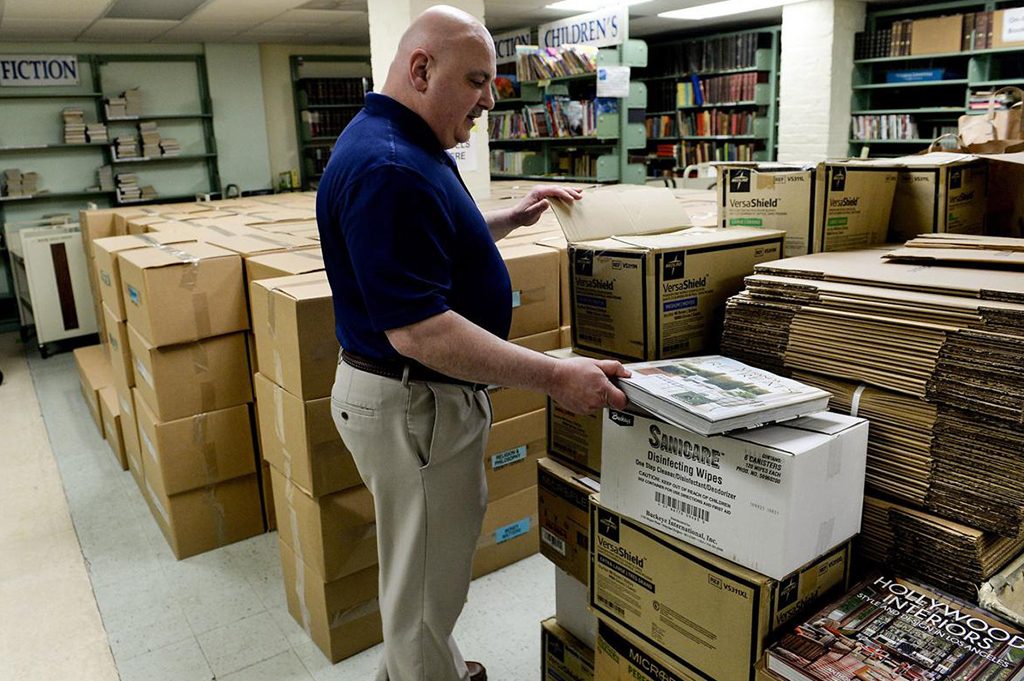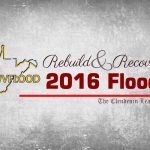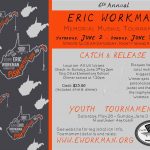Kanawha County Library Facilities Manager Tim Venitsoras looks over boxes of books in the basement of the main library in Charleston. The books are ready to go to a warehouse for storage before the annual book sale in October. Chris Dorst, Gazette-Mail
By: Ryan Quinn, Education Reporter | Posted: May 28, 2018 | Source: WV Gazette-Mail
In November, the Kanawha County Public Library system’s board unveiled and voted for an estimated $27 million renovation and expansion of the main library in Charleston.
Despite the planned 20,000-square-foot size increase, the system had begun working to remove about one-fifth of the 252,745 items in the Charleston library’s physical collection, and system Director Alan Engelbert said it probably will remain at about 200,000 items when the revamped main library opens.
Engelbert said the items are being sold, donated or, in certain cases, simply discarded.
The expanded library will have more spaces, he said, for people to meet and create, including a cafe, craft room and an expanded children’s area. He said it will include lower shelving and wider aisles that won’t be able to fit as many books but will “be a really nice collection to browse and use.”
He provided a breakdown by “broad collection type” of projected total items to be removed. He said the numbers represent the “minimum that we need to achieve in order to be able to fit our collection” in the new space.
The projected 51,478-item reduction is anticipated to include removing the following (original collection numbers are as of September):
- 24,078 (33 percent) of 72,614 “reference nonfiction” items
- 15,381 (16 percent) of 94,335 “children” items
- 6,630 (20 percent) of 32,896 “fiction” items
- 2,084 (29 percent) of 7,238 “young adult” items
- 1,854 (35 percent) of 5,350 “mass-market paperback” items
- 1,085 (13 percent) of 8,406 “audiobook/Playaway” items (Playaways are audiobooks with their own MP3 players)
- 314 (3 percent) of 10,915 “DVD” items
- 52 (1 percent) of 7,517 “CD music” items
- 0 out of 13,474 “miscellaneous” items
“We are reaching a balance between spaces for people and other types of activities libraries are engaged in while maintaining a very strong collection, both physical and electronic,” Engelbert said.
He said some of the children’s items are from the 1950s and ’60s; young-adult items tend to change rapidly in popularity; paperbacks tend to have condition issues and the reference collection is shrinking “because of the ever-increasing reliance on electronic sources.” He also said “nonfiction will not have as much space in the renovated building.”
Engelbert said between 30,000 and 35,000 items have already been withdrawn, with the majority currently in a warehouse, awaiting futures outside the county library system. He said he thinks there are, easily, 3,000 boxes of books there.
He said most removed — “weeded,” in library jargon — items are put up for sale at the annual book sale in October. He said relatively few of the withdrawn books were likely sold at the 2017 sale, and with the larger amount of recent weeding and Charleston Civic Center renovations limiting the size of last year’s sale, he expects this October’s sale to include an unusually large number of books.
After the sale, nonprofits may take what they want, Engelbert said. He said some items the system doesn’t think would be bought are given to Better World Books, a company whose website says it has “donated over 21 million books to partner programs around the world.”
Engelbert said other books are given to the West Virginia Regional Jail and Correctional Facility Authority or donated to local entities. He said items typically discarded straightaway include beat-up books and outdated travel, medical, legal and tax books.
Monika Jaensson, president of the library system’s board, said a “significant” number of books have gone to the new Clendenin branch, which is opening Wednesday. The June 2016 flood wrecked the previous branch there.
She also said local entities, like The Bob Burdette Center, are receiving books.
“If people can’t walk in the library because the shelves are too tight, then we’re not [serving] anyone,” Jaensson said.
She said she anticipates that the collection reduction is “going to actually increase the circulation,” while allowing space for lectures and presentations.
“We cannot continue to have the massive amount of books that we have in order to be a new library, to be a 21st-century library,” she said, noting that many now use electronic devices to pick up books. “We’re going to bring conversation back into the library. Important. Dialogue. Important. Learning.”
Pam Smith, president of the Public Library Association, a division of the Chicago, Illinois-based American Library Association, said it’s “very predominant that there’s competition for space in libraries when it comes to how people use space.”
“We need to be much more than a warehouse for books,” Smith said. “I think the focus on serving people and building skills and community, that’s the most important thing libraries can do. That said, part of that role is connecting people with ideas and books.”
But she noted that information comes in various ways, including through physical books, digitally and through people.
Monica Garcia Brooks, Marshall University’s associate vice president for libraries and online learning, said she has seen libraries change, including at Marshall, to where patrons are still using collections, but they might be doing so “on a device or camped out on a comfy chair using our wireless.”
“Libraries would prefer to buy, I don’t know, 30,000 e-books in one fell swoop, knowing that all of their patrons could use those materials 24/7, no matter where they are,” Brooks said.
Reach Ryan Quinn at ryan.quinn@wvgazettemail.com, facebook.com/ryanedwinquinn, 304-348-1254 or follow @RyanEQuinn on Twitter.








